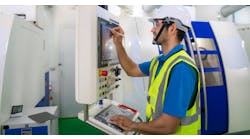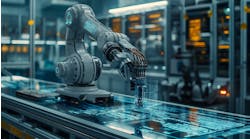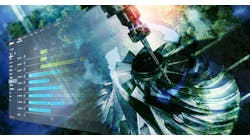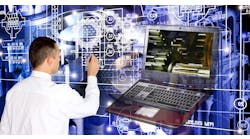As an integral part of the evolution of software development, artificial intelligence (AI) technologies are increasingly being embedded within every major enterprise software offering. The result is significant improvements in the way these systems operate, from being able to learn and analyze information to achieving intelligence and automation. As such, all major industries, including manufacturing, are being directly affected.
Manufacturing organizations are continuously looking for ways to increase productivity and operational efficiency. Looking to the new growing technology, the Industrial Internet of Things (IIoT), manufacturers are realizing that AI technologies are becoming a fundamental enabler of IIoT. AI provides factories not only with the ability to enable automation of tedious mechanical tasks but also the means to enable machines to “learn” and autonomously alert, improve, advise, and sometimes even make decisions regarding their own operation. So, to see maximum benefits of AI and IIoT, organizations should ask themselves what are the major benefits and effects of AI within an organization’s IIoT deployment strategy?
According to Merriam-Webster dictionary, the definition of artificial intelligence (AI) is, “the capability of a machine to imitate intelligent human behavior.”
This simple, yet all-encompassing definition summarizes the potential of software development since Alan Turing’s initial work in the computing field in the 1940s and 1950s. The goal of AI is to enable machines to perform activities and tasks like humans — and even better than humans.
Originally considered the part of science fiction and relegated to the activities of universities and research centers, AI has permeated nearly every aspect of modern life today. More and more devices today can perform complex, human-like complex tasks—from playing computer games to controlling and operating cars, without the help of a human driver. These complex activities are mediated by AI technologies—a blend of mathematical methods, new software technologies, and data for performing advanced analysis for intrinsic pattern discovery, prediction, and most importantly self-improvement (learning).
As data is a core component for AI, the evolution of software and hardware technologies that deal with data has had a radical impact on the adoption of AI-based technologies. One of these new technologies is called the Internet of Things (IoT).
IoT is a computing and networking paradigm that allows physical objects to be equipped with internet connectivity. Connection to the internet allows an ever-growing number of devices to generate and share an abundance of data and to communicate that information to other devices and to humans.
Industrial Internet of Things — The ability of organizations to collect large amounts of data from new sources, such as devices and machinery, represents a huge potential for exploring ways for technical and business improvement. The sudden emergence of vast amounts of data that organizations have at their disposal requires well-suited, powerful systems to analyze and transform that data into insights and even suggested decisions.
IoT has seen significant growth on the consumer goods sector. The technology has made it possible to connect a vast array of products and devices with various sensors and tools and to capture data about their operation and current state of functionality. The collection of data generated from a series of interconnected consumer devices and machines (mobiles, cars, etc.) for analysis enables an improvement in customer experience and ultimately quality of life.
Today, the Industrial Internet of Things (IIoT) is one rapidly growing and evolving version of IoT. IIoT enables the high-end interconnection within many industries. In particular, connected machinery and industrial devices are now being developed in manufacturing.
Over a relatively short period, IIoT has impacted software development efforts of manufacturing and other industries. Software systems, the main component of the data management infrastructure of companies, are undergoing changes that are paving the way to a radical transformation in the way companies produce and deliver both products and services.
So in this setting, how could manufacturers take advantage of an IIoT strategy with AI as a core component? What are the benefits and potential of this technology for the manufacturing industry?
AI gives an edge to IIoT — An IIoT initiative enables interconnection and data collection from myriad new devices. And this new interconnection paradigm needs a “brain” to direct activities—a central nervous system, so to speak, that processes and analyzes all the data to produce value in the form of insights, predictions, and even actions.
To maximize its potential and deliver the greatest value to an organization, an IIoT initiative needs to incorporate an effective set of analytics services, with AI as a core component.
An effective IIoT initiative needs to provide a comprehensive set of services—from basic data analytics services, such as real-time dashboards and key performance indicators (KPIs), to advanced services such as predictive analytics, machine learning, and AI. Furthermore, the IIoT initiative needs to have robust analytics to enable the completion of the data cycle—from data collection from manufacturing sources (equipment sensors, ERP systems, etc.) to the provision of advanced analytics services (see Figure 1.)
The general IIoT infrastructure for manufacturing, as denoted in Figure 1, depicts how organizations in the manufacturing industry can realize the tremendous value of AI and gain an edge.
Organizations stand to gain important and valuable information from traditional analytics such as the use of KPIs, charts, and dashboards from information points—thereby gaining real-time visibility and alerting about the current status of different aspects of production and operations. Traditional analytics will answer the 'what’s' and 'why’s' of an organization in a descriptive manner (see Figure 1):
• What is my overall operating efficiency (OOE)?
• What is my overall equipment effectiveness (OEE)?
• What is my overall machine downtime?.
On the other hand, the proper use of advanced analytics, such as predictive analytics and data mining, can improve the quality of insights generated, extending the capabilities of predictive analytics and providing answers for what-could-happen scenarios, in order to:
• Forecast product demand
• Improve sales planning
• Anticipate inventory turns.
Increasingly advanced techniques such as data mining and machine learning, among others—most of them subsets of AI—have already led to improvements in production processes and supply chains. Specifically, they play a vital role in improving planning production and distribution efforts, among other supply chain activities.
Moreover, as AI evolves, IIoT initiatives have the potential to reach higher levels of efficiency. Organizations can exploit emerging AI capabilities to conduct IIoT initiatives and perform “prescriptive” analytics. Here, the IIoT platform is not only able to anticipate but also to suggest, or even in certain cases to make, autonomous decisions. Examples of these capabilities include:
• Predicting equipment maintenance and anticipating downtimes
• Enabling equipment with auto-diagnostics features
• Automating product quality controls
While the incorporation of AI into administrative functions and supply chain activities has already delivered significant benefits, the introduction of AI in production environments has the potential to generate fully automated production systems that can make a stronger presence directly in the production of a wider number of specific manufacturing verticals (automotive, food and beverage, and others).
IIoT and AI complete the data value cycle — As manufacturing organizations across the globe connect their equipment to their IIoT platforms, more and more opportunities, and challenges, are being created for encouraging radical changes in the business, technical, production, and distribution environments of organizations.
But for these organizations to take advantage of the full benefits of an IIoT initiative, a strong and tight combination with analytics and especially with AI is needed to equip the decision-making process with tools that allow for simulating intelligent behavior and, if possible, making decisions with little or no human intervention.
For manufacturers, a key and valuable advantage is, and increasingly will be, to be able to gain insights and decision support based not only on the collection of data from traditional software enterprise components but also from the shop floor. Once shop-floor data is combined and analyzed properly to provide the right type of data according to level of need, AI offers opportunities for prescriptive information in the form of prediction, simulation, and decision automation.
Is that all? Most probably not. Over the coming years, as AI will continue to evolve, it will have an even deeper impact on virtually every industry, with manufacturing being no exception.
Organizations need to move rapidly and identify, consider, and evaluate AI and IIoT initiatives that can drive real value for their organization.
IIoT, seasoned with AI, could be your next best partner for success, no matter what role you play within your manufacturing organization.
Jorge García, is principal analyst for Business Intelligence and Data Management at Technology Evaluation Centers, a provider of professional software selection services.








